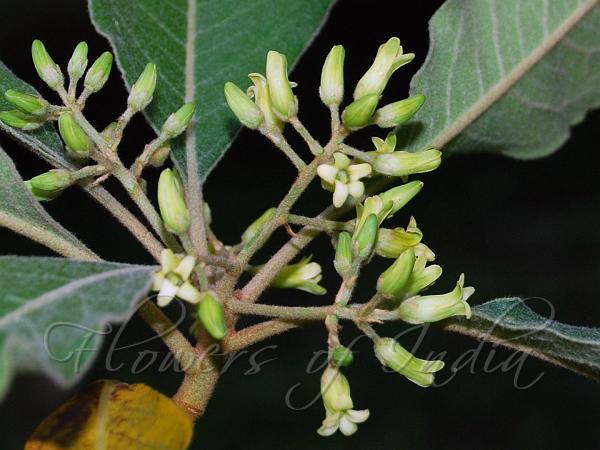|
| Doon Cheesewood |
|

|

| File size | 312947 |
| Original date | 4/7/14 1:51 PM |
| Resolution | 1440 x 1080 |
| Flash | Flash fired, return detected, auto |
| Focal length | 48.0mm |
| Exposure time | 1/125s |
| Aperture | 4.8 |
| Focus Distance | |
| Metering Mode | Multi-segment |
| Camera make | NIKON CORPORATION |
| Camera model | NIKON D80 |
| Sensor type | OneChipColorArea |
|
|
|
|
Photo: |
Botanical name: Pittosporum eriocarpum Family: Pittosporaceae (Pittosporum family)
Doon Cheesewood is an evergreen handsome shrub or a
small tree, easily differentiated from other Pittosporum species by its
velvet-hairy young leaves and fruits. This is a highly threatened and
rare species, confined only to a small region in Uttarakhand. The tree
may grow up to 6.5 m tall and a 1.2 m girth. Cultivated specimens may
grow much bigger. Plants growing under unfavorable conditions usually
become shrubs. The tree is more or less characterized with nearly
whorled spreading branches and stout twigs with white or pale velvety
hairs. at least when young. Bark is smooth, silvery grey or pale-brown,
very thin, with prominent small raised warts. Blaze is soft with
rather short fibre, white and sometimes yellowish-brown towards the
exterior. Leaves are loosely crowded towards the ends of branches,
very variable in size and shape, mostly broadly obovate,
obovate-oblong. They are 6-18 x 3-9 cm, pointed or shortly tapering,
entire, rather leathery with dense white or brownish velvet hairs on
both surfaces when young; upper surface tending to become hairless and
dark glossy green on maturity. Main lateral nerves are rather prominent
beneath, about 8-16 pairs, stalks 1.0-2.8 cm long. Flowers are borne
in short paniculate corymb-like clusters on peduncles 4-6 cm long.
Flowers are pale yellow, 7-8 mm long, on 0.5-1.5 mm long stalks.
Sepals are lanceshaped, densely velvet-hairy. Petals are 5, free,
erect, recurved at the top. Stamens are erect, filaments subulate,
anthers 2-celled, bursting inwards by slits. Ovary is densely covered
with long silky hairs, style short, stigma prominent. Fruit is a
capsule heavily velvety when young, mature capsule yellow and very
smooth, 0.8-1.6 cm in diameter, broader than long, tipped with the
persistent style. Doon Cheesewood
As the species is at the verge of extinction, most of the natives have
forgotten the plant and also its uses. However, in olden days, when the
plant was common in the forest, different parts of it were used for
various purposes by the natives. Young twigs and leaves provide one of
the best fodder for cattle, goats and sheep, and they were extensively
lopped in the past and even today by villagers for this purpose; thus
brining the plant in danger zone. Doon Cheesewood is found in NW
Himalayas, Dehradun, Mussoorie hills, Jeullikot in Nainital, Chamba,
and Mandi distt in Himachal. Flowering: March-April.
Medicinal uses: The bark is aromatic, when
freshly cut, and is said to possess narcotic properties. It was used
locally in chronic bronchitis and as an antidote to snake poison. The
plant yields an essential oil, which was used as a tonic, stimulant,
and was considered specific for certain skin diseases. The oil was also
applied by natives as in rheumatism, chest affections, sprains and
bruises. Wood was mainly used as fuel and also for making small toys.
The bark is aromatic, when
freshly cut, and is said to possess narcotic properties. It was used
locally in chronic bronchitis and as an antidote to snake poison. The
plant yields an essential oil, which was used as a tonic, stimulant,
and was considered specific for certain skin diseases. The oil was also
applied by natives as in rheumatism, chest affections, sprains and
bruises. Wood was mainly used as fuel and also for making small toys.
Medicinal uses:
 The bark is aromatic, when
freshly cut, and is said to possess narcotic properties. It was used
locally in chronic bronchitis and as an antidote to snake poison. The
plant yields an essential oil, which was used as a tonic, stimulant,
and was considered specific for certain skin diseases. The oil was also
applied by natives as in rheumatism, chest affections, sprains and
bruises. Wood was mainly used as fuel and also for making small toys.
The bark is aromatic, when
freshly cut, and is said to possess narcotic properties. It was used
locally in chronic bronchitis and as an antidote to snake poison. The
plant yields an essential oil, which was used as a tonic, stimulant,
and was considered specific for certain skin diseases. The oil was also
applied by natives as in rheumatism, chest affections, sprains and
bruises. Wood was mainly used as fuel and also for making small toys.
| Identification credit: Amber Srivastava | Photographed in Sahastradhara, Dehradun, Uttarakhand. |
• Is this flower misidentified? If yes,